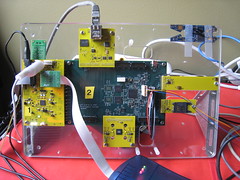Rosencrantz is maturing
April 23rd, 2007 by Mathew
The past few weeks have seen huge updates in the Rosencrantz HW land. The project is clearly starting to come together. A few of the different components are now working, and it’s become easier to visualize what else we need to get working, and how we will get there.
There’s a magical thing that happens when you are building digital hardware, where the hardware grows up from a series of loosely connected circuits (that don’t tend to be functioning in any way) to a cohesive unit, working together to accomplish the task we put in front of it. The hardware can’t work as a unit until its sub components not only achieve self awareness (they know how to work themselves, usually requiring firmware), but they also start to have a small amount of awareness of others (they know how to interact with the other components in the system). Seeing your project grow up is very exciting, and it’s not that far fetched for engineers to see themselves as parents of their projects, both excited and slightly nervous to let them out in the world to live their own lives and leave their own marks (we all know about the iPod™, but who among us can talk about the engineers who designed it – no the iPod left its own mark on the world, a mark independent of the people who created it). (more…)




